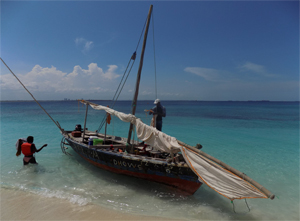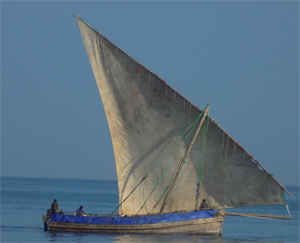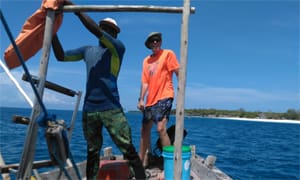To the editor: If you’ve ever been lucky enough to ride in a dhow, then you’ve truly experienced poetry in motion. They don’t sail so much as slide through the water, ghosting along as they drift under the gentle winds of the southeast monsoon.
For 2,000 years, these graceful lateen-rigged vessels have plied the Swahili Coast of East Africa, crisscrossing the northwest Indian Ocean to transport spices, timber, fruit, fresh water and people, their skilled pilots using nothing more than the North Star or line of sight for navigation.
Their origin is lost to history, but there are references to them in the writings of Marco Polo, who didn’t think much of the leaky vessels — which were stitched together using cords of fiber — “exposing merchants and others who make use of them to great hazards … [they] will not stand well in a storm.” Though frequently overloaded, they got Polo where he needed to go.
Dhows are still constructed on the beach by skilled shipwrights from mahogany, mangrove and teak, using only traditional building methods with hand tools and nails, which have taken the place of cord. The stout craft are usually around 30 feet with a draft of about 3 feet, and there is a wooden bimini over a poop deck with a low waist. Today they are primarily used to net fish and for tourism.
 |
|
A dhow on the beach. |
|
Robert Beringer |
The Zanzibar Archipelago is scattered over hundreds of miles off the east coast of Africa and was once a part of a vast trading empire ruled in turn by the Portuguese, Omani Arabs and the British. Zanzibar is commonly referred to as the Spice Islands. Today it is a mostly Muslim population and a semi-autonomous part of the developing nation of Tanzania.
On a recent visit to the island’s capital of Stone Town, the harbor was chockablock full with dhows as they sailed back and forth off Forodhani Park. I hitched a ride on one and received a reminder of the beauty of pure sailing, the kind I experienced when I first learned to sail as a 10-year-old on a Sunfish in Ohio: just me, the wind and the water.
As there is only one marina in Zanzibar, most dhows anchor just off the beach and are boarded by wading through the clear, waist-deep water. The dhow, like the Sunfish, carries none of the modern accoutrements mariners are accustomed to: there are no electronic instruments, running lights, galley or head; the bilge is emptied with a bucket; and, most troubling, no Coast Guard inspection plaque stating the legal limit for passengers. The only concessions to the modern world are life jackets and an outboard engine.
But my boat and crew came highly recommended (through Eco & Culture Tours) and, throwing caution to the wind, I jumped aboard. Captain Ahmed greeted me and quickly moved to weigh anchor, start the engine and get underway. I repeated my strange request to use only the sail, explaining that I was a longtime sailor from the U.S. and I wanted to experience a sailing (not motoring) dhow. His eyes lit up, and with a big smile he suggested that I take the tiller. “Well, if you insist.” I replied delightedly.
 |
|
A dhow underway displays its large sail area. |
|
Robert Beringer |
The boat tracked like a champ under its huge triangular sail, basically a genoa set on its side, reeling off about 5 knots as we progressed toward Bawe Island — a small resort that once was an operations station for the Eastern Telegraph Company, linking Cape Town with Zanzibar and Seychelles. There would be nothing to do there but relax: “No television, no shoes, no news,” said the droll website. And that was okay by me. Near the dock at the resort on Bawe, I headed into the wind where Ahmed dropped the grapnel and we spent a sublime hour snorkeling in vodka-clear coral waters.
Way too soon it was time to head back to Stone Town. The wind had shifted to the southeast, and I learned of the dhow’s shortcoming. The lack of a keel and jib means that they don’t sail well to weather. As he was starting the outboard, I asked Ahmed for an overview on tacking and he went through an arcane description in Swahili and English that I had difficulty understanding. I believe what he said was, “It’s difficult and I don’t want to do it now.”
Fair enough, it was his boat and there were more passengers waiting back at the beach. No doubt they would experience what I did: a few hours on a vessel that makes time stand still.
—Robert Beringer is a marine writer and college administrator who holds a USCG license and sails his Catalina 34, Ukiyo, out of Jacksonville, Fla.

